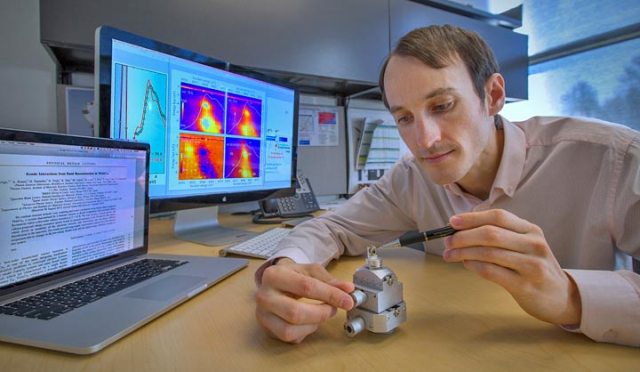Mar 31 2015
 Ignace Jarrige shown with the sample used in the experiment.
Ignace Jarrige shown with the sample used in the experiment.
Physicist Ignace Jarrige of the Brookhaven National Laboratory and Professor Jason Hancock of the University of Connecticut have led a study that has made a major advance in explaining a rare property of ytterbium-indium-copper-four (YbInCu4).
The breakthrough was achieved along with collaborators from the Argonne National Laboratory and from Japan.
This discovery holds promise for a host of next-generation technologies. Magnetic refrigeration, information storage, and other technologies that hold promise for the future, depend on sophisticated magnetic materials. The current study is a significant advance in that direction.
The manner in which magnetic impurities affect a material's electrical resistance is due to a physical phenomenon known as the Kondo Effect. This study is based on the Kondo Effect. Due to changing temperature, ytterbium-indium-copper-four (YbInCu4) undergoes a unique transition.
The magnetism of the material disappears below a specific temperature, while it demonstrates strong magnetism above that temperature. Physicists have been baffled by this transition for a very a long period; however, the reason behind this property has been revealed recently.
"We detected a gap in the electronic spectrum, similar to that found in semiconductors like silicon, whose energy shift at the transition causes the Kondo Effect to strengthen sharply," said Jarrige.
The manner in which electrons within a material are able to move is defined by the electronic energy gaps. These gaps play an important role in helping understand the magnetic and electric properties of materials. "Our discovery goes to show that tailored semiconductor gaps can be used as a convenient knob to finely control the Kondo Effect and hence magnetism in technological materials," said Jarrige.
The Department of Energy operates a synchrotron at The Argonne National Laboratory located outside of Chicago. This synchrotron can produce an intense X-ray beam, and this enabled the Resonant Inelastic X-Ray Scattering (RIXS) technique, which is a new experimental technique that could be used for uncovering the energy gap.
Materials were placed by the researchers in the focused X-ray beam. The manner in which the X-rays were scattered was sensitively measured and analyzed. This helped uncover the unique properties that were connected to their mysterious magnetic behavior. These properties included the energy gap.
This discovery paves the way for development of materials that possess strong "magnetocaloric" properties, which is the property of a material when under the influence of a magnetic field tends to change temperature. "The Kondo Effect in YbInCu4 turns on at a very low temperature of 42 Kelvin (-384F)," said Hancock, "but we now understand why it happens, which suggests that it could happen in other materials near room temperature." Hancock adds that the discovery of such a material would transform cooling technology.
In the US, every year, usage of air conditioners for residences costs over $11 billion in energy and this leads to release of 100 million tons of carbon dioxide. Mechanical fans and pumps are being used widel. If the magnetocaloric effect could be used for the magnetic refrigeration then it could help reduce the energy costs and carbon dioxide release.
This study has also led to the development of a new technique for research. "The RIXS technique we have developed can be applied in other areas of basic energy science," said Hancock. He added that it may help discover "topological Kondo insulators." These insulators have been predicted theoretically, but have not yet been discovered.
This study has been published in the journal Physical Review Letters.